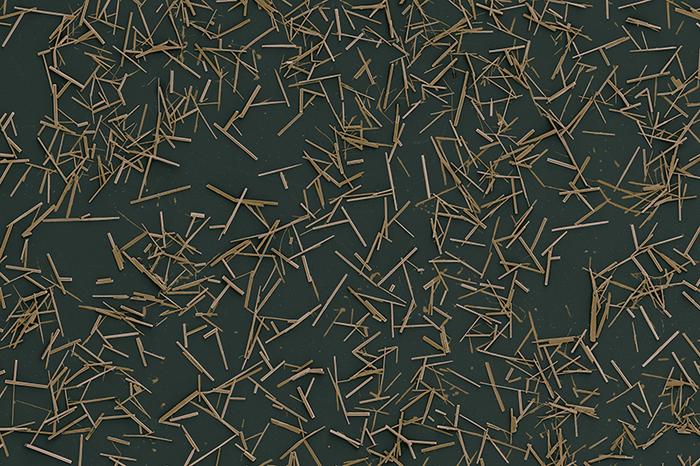WEST LAFAYETTE, Ind. — Purdue University engineers have developed a patent-pending method to synthesize high-quality, layered perovskite nanowires with large aspect ratios and tunable organic-inorganic chemical compositions.

Credit: Purdue University photo/Wenhao Shao
WEST LAFAYETTE, Ind. — Purdue University engineers have developed a patent-pending method to synthesize high-quality, layered perovskite nanowires with large aspect ratios and tunable organic-inorganic chemical compositions.
Letian Dou, the Charles Davidson Associate Professor of Chemical Engineering in the College of Engineering and associate professor of chemistry, by courtesy, leads an international team that includes postdoctoral research assistant Wenhao Shao and graduate research assistant Jeong Hui Kim of the Davidson School of Chemical Engineering.
Dou said the Purdue method creates layered perovskite nanowires with exceptionally well-defined and flexible cavities that exhibit a wide range of unusual optical properties beyond conventional perovskites.
“We observed anisotropic emission polarization, low-loss waveguiding below 3 decibels per millimeter and efficient low-threshold light amplification below 20 microjoules per square centimeter,” he said. “This is due to the unique 2D quantum confinement inside the 1D nanowire as well as the greatly improved crystal quality.”
The research has been published in the peer-reviewed journal Science. Dou and his team disclosed their innovation to the Purdue Innovates Office of Technology Commercialization, which has applied for a patent from the U.S. Patent and Trademark Office to protect the intellectual property.
Purdue method vs. traditional method
Shao said layered metal halide perovskites, commonly called 2D perovskites, can be synthesized in solution and their optical and electronic properties tuned by changing their composition. They easily grow into large, thin sheets, but growth of one-dimensional forms of the materials is limited.
“Traditional methods like vapor-phase growth or lithographically templated solution phase growth have high processing complexity and cost,” he said. “They also have limited scalability and design flexibility.”
Kim said the Purdue method uses organic templating molecules that break the in-plane symmetry of layered perovskites and induce one-dimensional growth through secondary bonding interactions.
“Specifically, these molecules introduce in-plane hydrogen bonding that is compatible with both the ionic nature and octahedron spacing of halide perovskites,” she said. “Nanowires of layered perovskites could be readily assembled with tailorable lengths and high-quality cavities to provide an ideal platform to study lasing, light propagation and anisotropic excitonic behaviors in layered perovskites.”
Dou said, “Our approach highlights the structural tunability of organic-inorganic hybrid semiconductors, which also brings unprecedented morphological control to layered materials. This work really breaks the boundary between the traditional 1D and 2D nanomaterials, combining different features into one material system and opening many new possibilities.”
Next development steps
“This is just a start of an exciting new direction,” Dou said. “We are currently developing new compositions and structures to further improve the lasing performance and stability. We are also looking into large-scale patterning of these 1D nanostructures to build integrated photonic circuits. We are also interested in partnering with industry to scale up the chemistry and device applications.”
Dou and the team received funding support for their research from the Department of Energy and the National Science Foundation.
The current work also involves collaborations with Purdue researchers Vladimir Shalaev, the Bob and Anne Burnett Distinguished Professor in Electrical and Computer Engineering; Brett Savoie, the Charles Davidson Associate Professor of Chemical Engineering; Alexandra Boltasseva, the Ron and Dotty Garvin Tonjes Distinguished Professor of Electrical and Computer Engineering; Libai Huang, professor of physical chemistry in the College of Science; and Yi Yu, associate professor at ShanghaiTech University.
Industry partners interested in developing or commercializing the work should contact Will Buchanan, assistant director of business development and licensing — physical sciences, wdbuchanan@prf.org, about track code 70422.
About Purdue Innovates Office of Technology Commercialization
The Purdue Innovates Office of Technology Commercialization operates one of the most comprehensive technology transfer programs among leading research universities in the U.S. Services provided by this office support the economic development initiatives of Purdue University and benefit the university’s academic activities through commercializing, licensing and protecting Purdue intellectual property. In fiscal year 2023, the office reported 150 deals finalized with 203 technologies signed, 400 disclosures received and 218 issued U.S. patents. The office is managed by the Purdue Research Foundation, which received the 2019 Innovation & Economic Prosperity Universities Award for Place from the Association of Public and Land-grant Universities. In 2020, IPWatchdog Institute ranked Purdue third nationally in startup creation and in the top 20 for patents. The Purdue Research Foundation is a private, nonprofit foundation created to advance the mission of Purdue University. Contact otcip@prf.org for more information.
About Purdue University
Purdue University is a public research institution demonstrating excellence at scale. Ranked among top 10 public universities and with two colleges in the top four in the United States, Purdue discovers and disseminates knowledge with a quality and at a scale second to none. More than 105,000 students study at Purdue across modalities and locations, including nearly 50,000 in person on the West Lafayette campus. Committed to affordability and accessibility, Purdue’s main campus has frozen tuition 13 years in a row. See how Purdue never stops in the persistent pursuit of the next giant leap — including its first comprehensive urban campus in Indianapolis, the new Mitchell E. Daniels, Jr. School of Business, and Purdue Computes — at https://www.purdue.edu/president/strategic-initiatives.
Writer/Media contact: Steve Martin, sgmartin@prf.org
Sources: Letian Dou, dou10@purdue.edu
Wenhao Shao, shao177@purdue.edu
Jeong Hui Kim, kim4017@purdue.edu
Journal
Science
Article Title
Molecular templating of layered halide perovskite nanowires
Article Publication Date
30-May-2024



